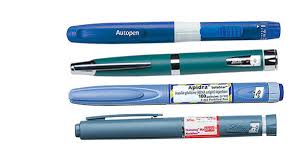There are many types of insulin each working in its own unique manner, some types of insulin are suitable for one but not for another. Normally basal insulin acting for almost 24 hours is used once at night and rapid acting insulin used with the main meals is used thrice or twice as the case warrants. Most insulin preparations come either in pen delivery devices which are disposable or refill pens. Some preparations of insulin still come in vials or small bottles. The pen delivery devices are easy to use and for those who are visually handicapped there are audible clicks while turning the dose dialer to help know the dose. The basal insulin is clear looking insulin. This acts for 16 hours to 36 hours. Normally does not cause low sugar spells and can be taken before or after food. The dose is usually dependent upon the fasting sugar levels. There is also premixed insulin preparations available which is a combination of short acting and intermediate acting insulin.
The commonly available basal insulin ( long acting) preparations in Oman are: Insulatard®, Detemir ( under brand name Levemir®), Glargine 100 units/ml( under brand name Lantus®), ultra long acting Degludec (under brand name Tresiba®) and ultra long acting Glargine 300 units/ml (under the brand name Toujeo®).
The bolus insulin (rapid acting insulin) comes either in small bottles or vials or pen delivery devices (either as disposables pens or those which can be refilled with cartridges) This insulin is clear looking insulin. This is generally taken 15 minutes to half an hour before the main meals.
The commonly available brands in Oman are Human Actrapid®( which can also be given into the veins in the hospitals when sugar levels are really high) Humalog Lispro®, Novorapid ® and Glulisisne ( under the brand name,Apidra®).
The basal ( long acting) insulin is preferably injected on the thigh and the rapid acting insulin on the abdominal wall avoiding 2 finger breadths around the navel or belly button.
The commonly available premixed insulin preparations available in Oman are Human Mixtard 30/70®, Humalog Mix 25/75®, Humalog Mix 50/50®, Novomix 30/70® and Novomix 50/50®. Because there is a clear and a milky insulin as the constituents, the insulin preparation bearing vial or cartridge will have to be shaken before use.
There are some barriers facing the patients and the treating doctors when advising insulin. The fear of low blood sugar levels, the fear of the pain associated with the needle prick, the need for having to check the sugar levels frequently, the cost of the insulin, the possible negative impact insulin can have on ones social and married life, the scary feel associated with the insulin, the impact insulin has on ones friends are the common barriers. There are some who have seen their near or dear ones die or having developed a kidney failure or having amputated a limb after staring insulin. They feel the insulin was responsible for all this. The uncontrolled sugar levels can damage the eyes, the nerves, the blood flow to the legs, the heart, the brain, kidneys and once the damage has set in, insulin cannot help reverse the damage, but can help further worsen the damage. The insulin can cause weight gain, might cause allergy or numbness for some and episodes of low sugar when the patient has taken too high a dose and either exercised or taken less food.
Insulin is safe during pregnancy, in those with very advanced kidney failure and heart failure.
There are however some points to be considered while using insulin:
- Insulin is to be stored either in a cool room. It is never to be frozen by placing in the freezer. If frozen by any chance, it cannot be thawed and is best discarded.
- Insulin can be taken along while traveling by carrying it wrapped in between ice packs or by using cooled gel holders. Sometimes you might need a certificate while traveling to be allowed in the cabin bag.
- Never leave insulin in the car especially during the summer as it can get damaged and lose its efficiency.
- Always check the expiry date especially while buying large amounts of insulin.
- Do not inject cold insulin. Roll the pen between the palms of the hand for six to seven times to lightly warm it.
- Rotate the site every time you inject.
- The site to be injected must be lightly cleaned with a swab. Check the site of injection for small swellings or bumps. These sites are to be avoided as the insulin will not act well if injected into those areas.
- The dose to be injected is dialed if using a pen insulin delivery system.
- Inject perpendicular to the skin after the needle is plunged fully. Plunge the dialer button to deliver the insulin.
- After the dose has been delivered, count to five and remove the pen, lightly wipe the injection site and cap the pen again to place it back in the refrigerator or in a cool room away from direct sunlight. Sometimes a drop of blood is seen coming after the injection. Light pressure to that site for half a minute will help.
- There is no need for a vigorous massaging of the site after the injection has been given.
- You will need to have the food consumed within ten to fifteen minutes of the rapid or premix insulin shots to prevent low sugar levels.
- Dispose the needles in a sharps container. It is advisable to change the needles after every injection.
- Do not wipe the needles with an alcohol swab as it removes the silicone coating on the needles and makes the injections painful.
- The dose of insulin will have to modified when traveling by long haul flights involving more than 15 hours either towards the East or the West.
Some precautions:
- If going for a party at night, it is safe to take the long acting insulin before the party if the patient is on a mix of short and long acting insulin. Take the rapid acting insulin after you come back home, and checking the sugar levels. Taking the rapid insulin before the party can lead to low sugar levels as there will be a delay in eating the food. Moreover, one is not sure of the kind of food either and how much one would consume.
- During Ramadan, please consult with your doctor on how best to take insulin.
Some myths:
- The dose of insulin always remain the same. The dose of insulin depends upon the sugar levels while checking.
- If I am sick and have not taken food, I do not need to take my insulin shots. When sick, though the appetite is compromised, the sugar levels will be high in response to the body`s defense mechanisms. Check the sugar levels and inject accordingly after consulting with your doctor. You might need either a smaller dose or higher dose depending upon the sugar levels.
Normally one unit of rapid acting insulin corrects sugar spike caused by intake of 10-15 gm of carbohydrate. (this is called the insulin to carbohydrate ratio) The carbohydrate content of food can be understood by referring to apps available on the smartphones or by checking on some sites such as www.carbsandcals.com
Another number to known is the insulin sensitivity factor. If you divide 1800 by the total dose of insulin taken in a day it will give the insulin sensitivity factor. Suppose you inject 50 units of insulin a day ( add all the insulin doses taken on a day), divide 1800 by 50 to get 36. This means by injecting one unit of insulin 36 mg/dL or 2 mmol/L of sugar comes down. This number will vary from person to person.
There are so many new insulin preparations and combinations being researched and soon to come into the market.
Points to consider while exercising if you are on Insulin:
Please check the sugar levels before exercising. If sugar level is < 5 mmol/L or 90 mg/dL, take 20 g carbohydrate, wait till the sugar levels reach 7 mmol/L ( 126 mg) . If sugar levels are between 10-15 mmol/L( 180-270 mg/dL) you can still exercise but be reminded that the sugar levels go up while exercising. If sugar levels before exercising are above 15 mmol/L (more than 270 mg/dL), check ketone levels in blood( there are blood ketone meters available with Freestyle® which uses a test strip for ketone like using the glucose test strip) If the blood ketone is between 0.6 to 1.4 mmol/L, you can do moderate intensity exercise and drink more fluids for half an hour. If the blood ketone levels are more than 1.5 mmol/L, you need to meet the doctor for correction of the sugar and ketone levels with insulin and IV fluids. Upper abdominal pain and nausea or vomiting can be sign of high blood sugar levels.
During the exercise you might need to snack in between depending upon the duration . An exercise time of not more than an hour needs no carbohydrate replacement, if the exercise duration is between an hour to 2 hours, take 30-60 gm carbohydrate snack and some water. If the exercise duration is more than 2 hours, take 30 gm carbohydrate every 20 minutes with water.
Prevention of low sugar levels after exercise : If doing exercise 2 hours after taking basal insulin, reduce the dose of basal insulin by 20%. If doing the exercise in the late afternoon or evening, reduce the dose of basal insulin by 20% at night to prevent low sugar episodes. A short sprint before or after the exercises causes a spike in sugar levels which prevent getting low sugar following the exercise regime. A proper cooling down after exercise can prevent the high sugar levels soon after exercising.













